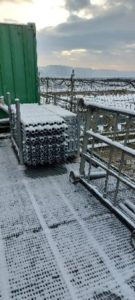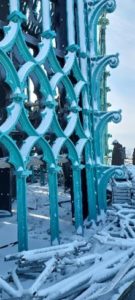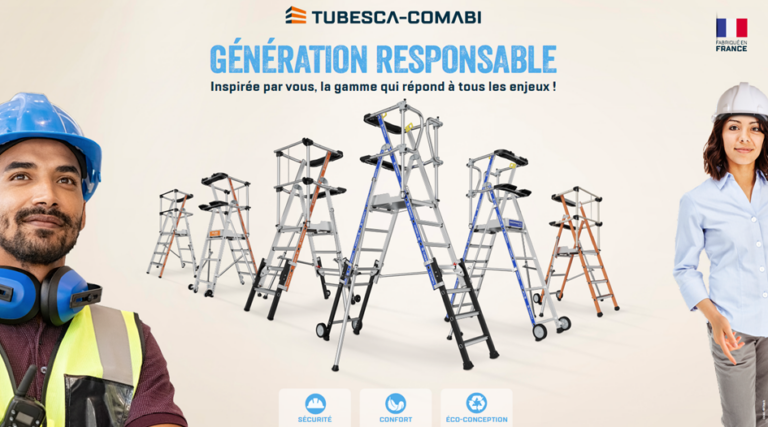- Emblematic worksite
Rouen Cathedral, taking on France’s tallest classified historic monument
Since 2016, the Tubesca-Comabi have been involved in the ongoing work on the spire of Rouen Cathedral. Our teams have provided a 152-metre scaffolding solution to enable this restoration work. In collaboration with Lanfry, Tubesca-Comabi has taken on an impressive task of catering to the tallest classified historic monument in France: The spire of Rouen […]
Since 2016, the Tubesca-Comabi have been involved in the ongoing work on the spire of Rouen Cathedral. Our teams have provided a 152-metre scaffolding solution to enable this restoration work.
In collaboration with Lanfry, Tubesca-Comabi has taken on an impressive task of catering to the tallest classified historic monument in France: The spire of Rouen Cathedral. This prestigious and extremely technical worksite, which is expected to take 7 years to complete, will be split into multiple technical phases. Phase 5 has now been launched!
Our expert
Jean-Baptiste Spinicci, Technical Sales Director. An incredible record of 15 years of experience within Tubesca-Comabi.
Scaffolding the peak of “the city of a hundred bell towers”
Rouen Cathedral is an iconic monument for French’s historic heritage. Its cast iron spire alone measures an exceptional 61 metres in height, peaking at 152 metres. Its structure is reinforced with weathering (COR-TEN) steel, following consolidation works undertaken in 1976 to bolster its wind resistance. In 2015, the Regional Directorate for Cultural Affairs of Haute-Normandie initiated a full restoration operation for the spire, which had become fragile.
The aim of the restoration work is to treat the deterioration issues associated with the two materials composing the spire: weathering steel and cast iron. This is no mean feat, requiring multiple interventions: Unsealing the paint (last done in 1914), replacing missing parts, treating and consolidating elements that have become fragile, replacing attachments, and treating the surface with an appropriate paint system.
“The particularity of a cathedral environment is that there are many protruding elements that are extremely fragile, such as sculptures and gargoyles, which you absolutely mustn’t damage. Out of respect to the historic elements, we have to use anchor points in stone seals, which allow us to stabilise our scaffolding.”
The worksite is a display of absolute technical prowess, given the specifics of the environment and the religious structure at stake. Rouen Cathedral’s spire presents complex and asymmetrical architecture:
- No support can be placed onto the roofs of the naves or the windows;
- Fragile protruding elements (statues, gargoyles, etc.) characteristic of Gothic architecture;
- Mooring restrictions, requiring mooring in stone seals in order to avoid breaking or piercing the stone.
152 m of scaffolding in 7 assembly phases
“We’re committed to stepping up to the challenge of scaffolding the tallest point of historic monuments“, explains Jean-Baptiste Spinicci. “The scaffolding will be erected up to a height of 152 m, and the work will be carried out across 7 phases”.
The worksite’s living quarters are located inside the base of the spire. The scaffolding will be erected in multiple instalments, in sections: platforms, installed every 20 m, will support th scaffolding. Once a phase is completed, a platform will be set up for the assembly of the next phase. only the South façade of the cathedral will be continuously equipped. It will include an intermediary platform for storing materials and equipment, and will also be used as a starting point for lifts and stairways.
The scaffolding solution chosen for this project is the multi-directional M368 (8 positions). The use of this material means that we can work on 100% of the geometric and architectural forms. For phases 3, 4, 5, and 6, the scaffolding will be 100% sheeted to protect the sealing. At altitudes like this, and in a region like Normandy, this requires exceptional technical expertise. The scaffolding will be accessible via lifts and UNISTEP stairways (machine-welded aluminium). They’ll provide access to each zone, in sections, and will rise to heights of up to 120 metres.
Some key figures on the multi-directional M368 for Rouen Cathedral’s spire:
- 152 metres high, all phases counted;
- The scaffolding has been designed to support 500 kg/m2 with a mobile load of 1.5 tonnes;
- Resistance of 600 kg/m2 on the platforms.
An occupied and in-use worksite
The Rouen Cathedral worksite will be completed on an occupied and in-use worksite: Mass will be held in the cathedral throughout the scaffolding assembly and disassembly phases. Therefore, the worksite will have to be regularly interrupted, which requires a certain level of flexibility in working hours.
“Seeking innovating in assemblies”
Renowned for its expertise in working on historic monuments, Tubesca-Comabi demonstrates exceptional technical know-how. ” We are able to react and respond through our solutions. Our expert engineers in our worksite application design office are always finding alternative solutions to overcome any difficulties encountered. We’re able to innovate and think out of the box to find new technical solutions. This is an asset that’s particularly appreciated by architects working on historic monuments. “, adds Jean-Baptiste Spinicci.
“ We never drop the ball or just think “that’ll do”. It’s the constant quest for innovation in our assemblies that has set us apart from the rest. Time and time again, we’ve proven our ability to satisfy this type of request. ”
For the restoration of this unusual and unique site, the chosen product is 100% standard. It’s the custom assembly solution that really caters to all of the specificities, the technicality, and the particularity of this worksite. This scaffolding assembly is also equipped to collect cleaning water. A watertight system with wastewater drainpipes along the entire length of the spire, the scaffolding, and the platform, from the peak down to the ground.
“Our expertise and experience in the heritage sector is a major asset. Our most impressive reference is, without a doubt, theAubervilliers chimney worksite: A 40-metre freestanding scaffolding structure! Technical prowess that hadn’t be possible to achieve by any other scaffolders. “, explains Jean-Baptiste Spinicci.
This worksite was a real challenge for the on-site teams. During the 4th phase, we had to ensure the continuity of the lift inside the building, going up 65–85metres, and install the scaffolding both inside and outside, at a height of 85 metres.
We then had to remove the scaffolding from phase 3 in order to simultaneously assemble the phase 4 scaffolding (85 metres to 102 metres), whilst also ensuring the durability of the thermoformed sheeting.
How’s it looking today?
Phase 5, which is focused on restoring the spire at 103–125 metres high, began on Wednesday 17th January 2024. The assembly is expected to take one month to complete, marking the start of 12 months of intensive work to restore the cast iron spire to its former glory.
Stripping and painting:
One of the first steps in this crucial phase will be the stripping of the cast iron structure, followed by a meticulous painting operation. These processes are essential to preserving the spire’s resistance against weather and external elements. The workers will pour all their expertise into restoring this iconic structure to its former glory.
Decontamination area for lead:
A key aspect of this restoration project is the creation of a decontamination area for lead. Taking care of workers’ health is a non-negotiable priority, and this system will allow us to ensure optimal protection against any risks associated with handling potentially toxic materials.
Installation of a third lift:
In order to facilitate the transportation of equipment, a third lift will be added for phase 5. This logistical improvement will help to optimise the efficacy of operations whilst also ensuring the safety of those working at what can only be described as dizzying heights.
This is reiterated by Jean-Charles Durand, Works Engineer at Tubesca-Comabi, ” The higher we go, the more challenging the climate challenges for our workers (wind, rain, snow, etc.). The altitude paired with the winter conditions makes it extremely arduous to get scaffolding parts up there. ”
We provide custom scaffolding solutions, adapted to all your worksite profiles! Contact us!






